- GreenMatch
- Ocean Pollution: Key Facts and Trends 2025 Update
Ocean Pollution Facts: Statistics & Rankings (2025)

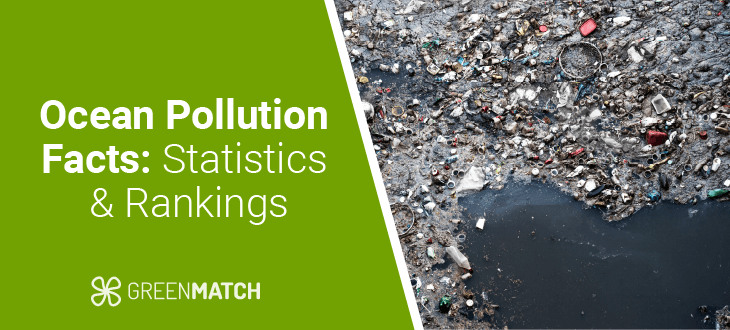
- An estimated 75 to 199 million tonnes of plastic is currently in the ocean.
- 92% of microplastics have been found in 60% of fish that we consume each year and are linked to health risks such as cancer, infertility, and nervous system damage.
- Asia is responsible for 81% of ocean plastic pollution due to poor waste management, single-use plastics and inadequate recycling centres.
- Over 3 billion people depend on the ocean for livelihoods, yet pollution has led to declining fish stocks and job losses in affected communities.
- The Ocean CleanUp is aiming to remove 90% of floating waste by 2040 and has successfully removed 11.5 million kilos of waste so far.
The ocean is a mysterious and vast environment which is home to thousands of biodiverse ecosystems, providing livelihoods to billions of people and supporting communities throughout the world. It helps reduce CO2 emissions, regulate global temperatures, and slow down the rate of global warming. But in recent years, ocean pollution has become a major concern, and it continues to grow. Through human activities such as over-consumption, the use of single plastics, poor recycling practices and waste management, we have slowly begun to destroy the ocean. Failing to protect our oceans will increase climate change, leading to devastating consequences for human life.
This is why it is essential to familiarise yourself with current facts about ocean pollution. By educating yourself on ocean pollution statistics, you can make conscious efforts to fight climate change and help reduce waste in our oceans. In this statistical overview, we will dive into the most up-to-date ocean pollution facts, highlighting the urgent need for action.
General ocean pollution facts & statistics
The ocean, covering two-thirds of our planet, not only sustains marine life but provides climate regulation and serves as a major driver of global economic growth. However, human activities have contributed to ocean pollution, putting at risk ecosystems, wildlife, human life and economies. By understanding ocean pollution facts and statistics, you can help reduce your own impact on the ocean and take vital steps in reducing this global crisis.
- The ocean is responsible for absorbing over 90% of the world's heat.
- A rise in ocean temperatures can lead to coral bleaching, destruction of glaciers and ice sheets and an increase in sea levels.
- In 2024, ocean surface temperatures were 0.97 degrees warmer than the 20th century average.
- 75% of the ocean’s coral reefs have been impacted by coral bleaching due to rising heat temperatures.
- More than 3 billion people rely on the ocean for their livelihoods, including food and energy sources, as well as providing millions of jobs per year.
- 75 to 199 million tonnes of plastic is estimated to be in our oceans.
- An estimated 8 to 10 million metric tons of plastic enter the ocean every single year, which is equivalent to around 0.5% of the world’s plastic.
- There are 1.9 million pieces of plastic per m2 in our oceans, according to analysis by the University of Manchester
- Researchers believe that the majority of plastic is unseen and is likely at the bottom of the ocean.
- The majority of plastic in the oceans comes from land-based sources (70 to 80%), while an additional 20 to 30% comes from marine sources such as fishing and other vessels.
- By 2050, UNESCO reports that plastic will outweigh all fish in the sea.
- An estimated 92% of plastic in the ocean is microplastics (which is plastic smaller than 5mm).
- The most commonly found plastics in the ocean include cigarette butts, food wrappers, plastic bottles and caps, straws, cups, plates and single-use plastic bags.
- 60% of fish contain microplastics, and 1 in 3 fish caught for consumption contain plastic.
- Run-off from wastewater facilities, agriculture and the use of fossil fuels can result in nutrient pollution in our oceans, where excess nutrients reduce the oxygen levels in the water.
- As a result of nutrient pollution, dead zones can appear, which prevents marine life from living due to the lack of oxygen.
- Currently, there are around 405 dead zones around the world.
- The largest dead zone is located in the Gulf of Mexico and is currently 6,705 square miles in size.
- Due to pollution, there are five major garbage patches in the ocean consisting of floating litter and other debris.
- The largest garbage patch is the Great Pacific Garbage Patch which is estimated to cover 1.6 million square kilometers, making it twice the size of Texas.
- The Ocean CleanUp has confirmed that as of 2024, it has removed ten million kilograms of litter from oceans and rivers around the world.
- In 2022, the United Nations Environment Program created “The Global Plastic Treaty”, which aims to end plastic pollution by 2040.
How much plastic and trash are in the ocean in 2025?

As of 2025, there is currently an estimated 75 to 199 million tonnes of plastic and waste in our oceans. This number is set to increase if action is not taken, with 33 billion pounds of plastic entering the oceans every year. This shocking statistic leads many to believe that by 2050, the total amount of plastic in our oceans and waterways will outweigh all the fish in the sea.
Between 70 to 80% of plastic in the ocean comes from land-based sources. With littering, poorly managed waste facilities and overflowing landfills and bins being major contributors. These plastics are often carried by drainage systems, wind, rain and floods, with rivers playing a massive role in carrying plastic waste inland to the ocean.
According to the UN, an estimated 1,000 rivers are accountable for nearly 80% of riverine plastic emissions into the ocean every year. Currently, there are five garbage patches in our oceans: two in the Atlantic, two in the Pacific and one in the Indian Ocean. This poses a serious threat to marine life and ecosystems.
A garbage patch is a large area in the ocean consisting of floating plastic, litter and debris which comes together due to ocean currents.
By improving waste management systems and focusing heavily on better ways to recycle plastic, we can prevent the number of plastic and trash from increasing exponentially each year.
We still have a very poor understanding of how much total plastic has accumulated in the oceans. There seems to be one emerging scientific consensus, which is that most of that plastic is not floating on the ocean surface.-Roland Geyer.
Biggest causes of ocean pollution
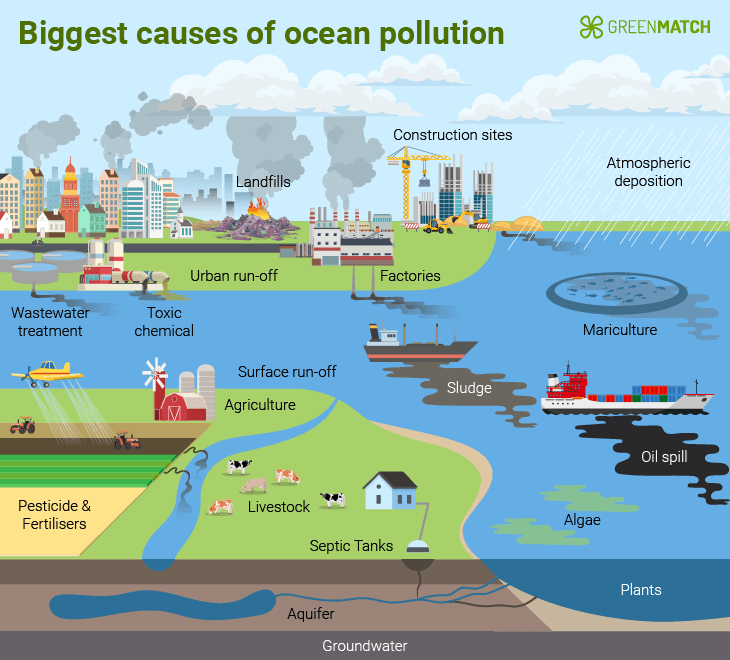
The biggest cause of ocean pollution is non-point sourcing, which is when rainfall or snowmelt moves across the ground, picking up pollutants along the way and eventually depositing them into rivers, lakes, coastal waters and groundwater. The pollutants are from a number of sources, such as:
- Oil, grease and other toxic chemicals from energy production and daily activities.
- Fertilisers, herbicides, and insecticides used in agriculture increase the nutrients in the waterways, causing “nutrient pollution” leading to water sources depleting in oxygen and resulting in dead zones.
- Sediment and waste from improperly managed construction sites.
- Atmosphere deposition where water particles mix with carbon dioxide, sulphur dioxide and nitrogen oxides to form a weak acid. These acidic water particles are then released to water sources when it rains.
Plastic waste is another huge contributor to ocean pollution and contributes to about 80% of marine debris, according to IUCN, which can be caused by non-point sourcing, where rainwater or snowmelt washes away plastic from overflowing landfills and bins. However, unintentional or intentional dumping also contributes to plastic waste in our oceans.
Light pollution affects 22% of the world’s coastlines. Artificial lighting disrupts marine ecosystems, particularly plankton and coral systems, which rely on natural light cues for spawning and migration. Disruptions to these processes can lead to food chain collapses and habitat loss, according to the University of Plymouth.
Noise pollution from shipping, deep-sea mining, military activities and offshore windfarms can have a devastating effect on marine life which relies heavily on noise to communicate and interact with their world. Noise pollution in our oceans can affect the hearing and stress levels of marine life, disrupt breeding habits, and interfere with communication.
Most polluted oceans in the world
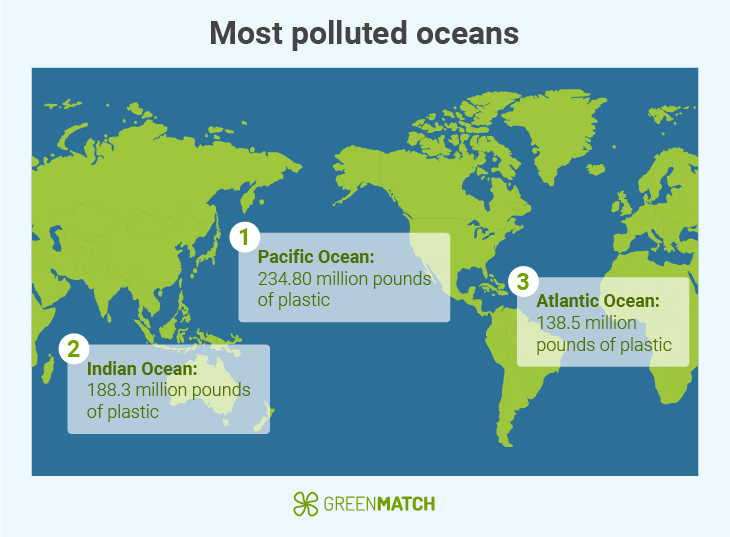
The Pacific Ocean
The Pacific Ocean is considered the most polluted ocean, with an estimated 234.80 million pounds of plastic found. Due to vast amounts of pollution in this ocean, the Great Barrier Reef and other coral systems are affected by coral bleaching, which threatens marine life and their habitats. The Ecological Monographs journal has stated that coral bleaching is increasing between 19% to 38% each year, preventing these fragile ecosystems from recovering.
It is home to the Great Pacific Garbage Patch, the largest one in the world, comprising mostly of fishing waste and plastic. While this visible waste shows just how polluted this ocean is, research states that 70% of marine debris is actually beneath the surface with a recent expedition of the Mariana Trench, the ocean’s deepest point, finding a plastic bag. A 2022 study found that almost half of marine life in the Pacific Ocean consumes plastic. Additionally, the Pacific has the highest volume of overfishing in the world, both legally and illegally, having devastating effects on marine habitats and aquatic populations.
The Indian Ocean
The Indian Ocean is the second most polluted ocean in the world despite its vast biodiversity and support of multiple communities who rely on the ocean for their livelihoods. According to Greenpeace, the Indian Ocean is termed a global hotspot for marine diversity.
Countries such as Indonesia, Thailand and India, which are considered the highest ocean plastic polluters in 2025, all have access to this ocean, which contributes to its high levels of pollution. As a result, an estimated 11 million tonnes of plastic is dumped into this ocean each year. Additionally, the Indian Ocean has a drainage system of the biggest polluted rivers in the world, the Ganges and the Indus. On top of plastic waste concerns, the Indian Ocean accounts for 40% of the world’s offshore oil production. While oil spills have decreased in recent years, they still occur, causing devastating impacts on marine life.
The Atlantic Ocean
The Atlantic Ocean is the third most polluted ocean in the world. With access to major rivers, such as the Amazon, Mississippi and the Congo, this ocean is more susceptible to in land plastic being carried by the rivers into the ocean. This ocean contains two major garbage patches, both in the North and South. Research has shown that there is at least 10 times more plastic polluting this ocean than originally thought. An additional study sampled 200m of the Atlantic's surface and found 7,000 microplastics per cubic metre.
Our key finding is that there is an awful lot of very, very small microplastic particles in the upper Atlantic Ocean, much higher than previously estimated. The amount of plastic has been massively underestimated- Katisaryna Pabortsava, UK’s National Oceanography Centre.
Our oceans play a vital role in climate regulation, the global economy, and sustaining diverse life. They absorb 30% of atmospheric CO2, acting as a crucial buffer. Phytoplankton within them produce 50% of the world’s oxygen. Over 90% of global trade relies on sea routes, supporting millions of jobs, while more than 3 billion people depend on the ocean for their livelihoods. Understanding ocean pollution statistics is essential for taking meaningful action to combat and reduce pollution.
The highest ocean plastic waste polluters in 2025
The highest ocean plastic waste polluters in 2025 primarily stem from countries in Asia, inputting a shocking 81% of the plastic waste into the ocean. Asia covers 30% of the world’s landmass and consists of 48 countries in total. Here are the top ten highest ocean plastic waste polluters in 2025 per country:
| Ranking | Countries | Annual plastic waste per metric ton |
|---|---|---|
| 1 | Philippines | 360,000 |
| 2 | India | 130,000 |
| 3 | Malaysia | 73,000 |
| 4 | China | 71,000 |
| 5 | Indonesia | 56,000 |
| 6 | Myanmar | 40,000 |
| 7 | Brazil | 38,000 |
| 8 | Vietnam | 28,000 |
| 9 | Bangladesh | 25,000 |
| 10 | Thailand | 23,000 |
Factors behind top ocean polluters in 2025
So why do these countries produce so much ocean pollution, and is there any way to address these issues to help reduce ocean pollution? By understanding the factors behind top ocean polluters, we can work on fixing the problems worldwide:
- Poor waste management infrastructure: Proper waste management systems help reduce pollution as its main goal is to increase a product’s life cycle through organisation and recycling. In many countries, poor waste management can contribute to an increase in landfills, which may overflow.
- Single-use plastics: Many countries with large proportions living just under the poverty line use single-use plastics as they are much more affordable and convenient.
- Limited recycling infrastructure: Some countries such as the Philippines lack adequate recycling centres which leads to more waste ending up in the ocean. It is estimated that a shocking 70% of Filipinos lack access to disposal facilities.
- Importation of foreign waste: Many countries, specifically in the West, export their waste to poorer countries to alleviate their waste issues. As a result, poorer countries with less robust waste management facilities lead to an overall increase in pollution.
- Tourism: Tourism is said to generate about 35 million tonnes of waste annually, according to a 2022 study. Tourist hotspots see an increase in plastic and food waste every year.
Ocean pollution impact facts
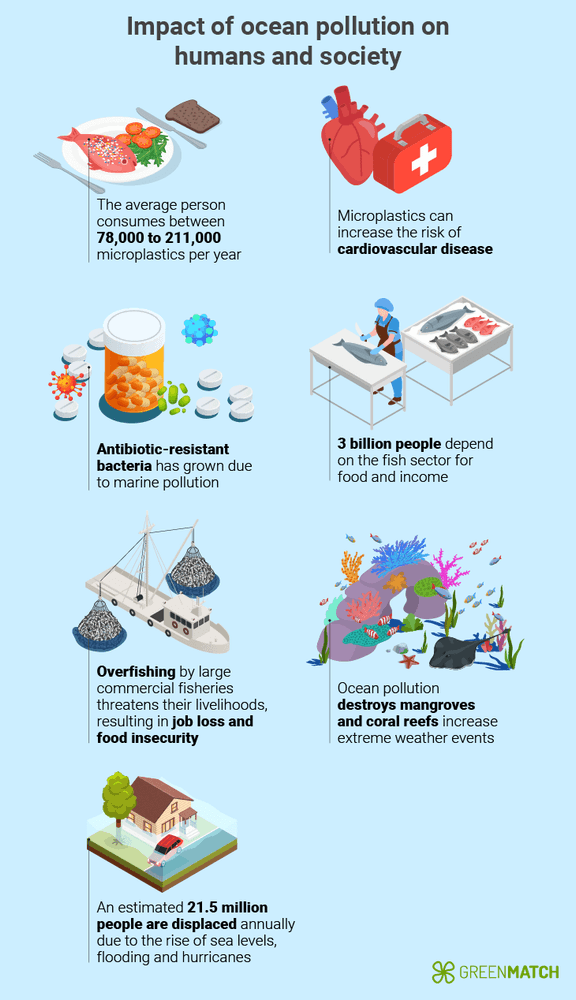
Ocean pollution continues to grow and has devastating consequences for marine life, ecosystems, humans and society as a whole. From microplastics in our bodies to declining fish populations, the effects of ocean pollution extend far beyond the ocean. Understanding ocean pollution impact facts is crucial for taking action to protect our planet and future generations. Below, we explore how ocean pollution affects humans and society.
Impact on humans
- The average person consumes between 78,000 to 211,000 microplastics per year, with these plastics being found in the lungs, heart, and even brain.
- While there is limited research on the effects of microplastics, a recent study found that these plastics in humans can be a potential risk factor for cardiovascular disease.
- Mercury and PCBs are the top pollutants in the ocean. Infants in utero exposed to these pollutants through their mother’s consumption of contaminated seafood are at a higher risk of developing damaged brains, reduced IQ, and increased risk of ADHD, Autism and other learning disorders.
- Adults exposed to these pollutants have an increased risk of cardiovascular disease and dementia.
- Manufactured chemicals found in the oceans can reduce male fertility, increase the risk of cancer and have the potential to damage nervous systems.
- An increase in antibiotic-resistant bacteria has grown due to marine pollution. Marine life that consumes this bacteria and is then used for human consumption can pose life threatening illnesses which cannot be treated by antibiotics.
Impact on society
- 3 billion people depend on the fish sector for food and income, but overfishing by large commercial fisheries threatens their livelihoods, resulting in job loss and food insecurity.
- Marine debris impacts tourist-dependent communities as their locations may become undesirable due to an increase in pollution. A NOAA-funded study found that beaches in Alabama impacted by ocean pollution saw a decrease in 1 million visitors per day, resulting in a loss of $113 million (£89.6 million) and a decrease in almost 2,200 jobs.
- Ocean pollution, which damages essential habitats such as mangroves and coral reefs that act as natural carbon sinks, can accelerate climate change. This increases extreme weather events that can devastate entire communities.
- Poorer countries and marginalised communities that produce less carbon emissions suffer the most from ocean pollution, increasing social inequality and environmental injustice. For example, Pakistan emits 1% of greenhouse gases, yet in 2022 faced the worst flood in its history due to climate change, resulting in 15% of its population being displaced.
- The rise of sea levels, flooding and hurricanes have increased the number of climate refugees, with an estimated 21.5 million people displaced annually. Of these climate refugees, 90% of them come from poor developing countries.
Ocean cleanup: current efforts & costs
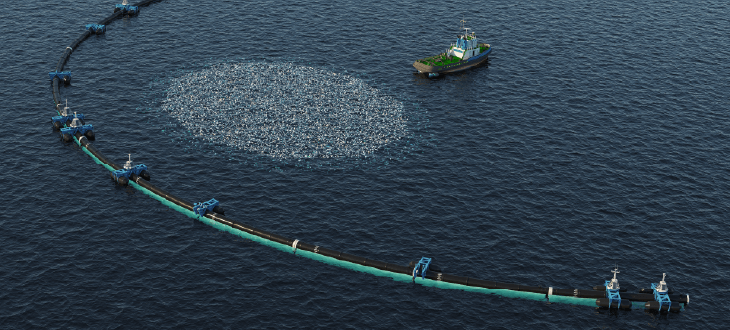
Understanding facts about pollution in the ocean is essential to encourage productive change but can feel overwhelming and even hopeless at times. Luckily, there are some great efforts being made throughout the world to combat ocean pollution in 2025. Here is a look at the current efforts to help combat ocean pollution and their associated costs.
Ocean Cleanup
The Ocean Cleanup is a non-profit organisation based in the Netherlands hoping to tackle ocean pollution on a large scale. Their main goal is to intercept plastic in rivers to prevent a further influx of plastic entering the ocean and to also remove waste that is currently found in our oceans. Their ambitious goal is to clean up 90% of floating plastic by 2040. The Ocean Cleanup has created an advanced U-shaped barrier that is cast into areas with a high density of plastic in the ocean. This barrier pulls the plastic together which is then collected. As a result of this technology, The Ocean Cleanup confirmed that they removed 11.5 million kilos of trash from rivers and oceans.
The Ocean Cleanup’s main goal is to reduce the Great Pacific Garbage Patch, the largest one in the world, and estimated that it would cost $7.5 billion (£5.95 billion) to do so. Although this seems like a high number to ordinary people, if governments collectively contribute, this could be made possible.
Seabin
The Seabin project’s goal is to help remove plastic, oil and other pollutants from marinas, harbours and other waterways. They use their own specialised device, the “Seabin”, which works as a fish tank-like filtration device to remove debris and clean the waterways. As of 2023, the Seabin Project confirmed that they have removed 4.7 million plastic items, including 2.3 million microplastics.
The cost to run one Seabin, based on its electricity usage, is around $3.70 (£2.94) per day, with a yearly total of $1,332. They aim to have deployed their technology in over 100 countries by 2050.
Fishing for litter
Kimo, a multinational organisation comprised of several European countries, is making headway in removing waste from the ocean by creating “Fishing for litter”. Members of Kimo provide fishing men with large bags to collect any plastic and waste they encounter during fishing. This comes at almost no cost as the fishermen are deemed as "volunteers". Not only does it help remove waste but increases awareness in the fishing community.
Government policies and efforts
Not only are NGOs and individuals making headway in reducing ocean pollution, but governments throughout the world are beginning to make a conscious effort in creating policies to ensure the limitation of pollution moving into the future. Here are some efforts created by EU governments:
- EU single-use plastic ban: The European Union has developed a plan which will ambitiously remove single-use plastic completely from Europe by 2030. This includes thin plastic bags and mini cosmetics in hotels. Additionally, in this plan, countries would need to ensure that 90% of their plastic bottles are deposited in an attempt to recycle rather than dump them into landfills.
- UN global treaty on plastic pollution: Currently under negotiations, this legally binding agreement will ensure that all committed countries will work together to reduce pollution. As of today, 175 countries have agreed to this treaty and it is due to be completed by mid-2025.
The future of ocean pollution
We rely on the ocean more than we realise, but climate change, overconsumption, and poor waste management have led to its slow destruction. Although it is easier and more comfortable to ignore these problems, ocean pollution is still there, threatening marine life, ecosystems, and, ultimately, human survival.
This may all seem hopeless, but the most important step in taking action is understanding ocean pollution statistics. By educating yourself on what’s going on, you can make informed decisions to reduce your impact on the ocean. All hope is not lost. Non-profit organisations are making huge efforts to remove floating plastic, scientists are developing new technologies to reduce plastic and microplastic pollution, and governments are ensuring stricter bans and signing international environmental treaties. We must face this problem head on instead of sticking our heads in the sand. Direct action is the only solution.
Fighting for the ocean means fighting for our future. By making more conscious choices around recycling, reducing plastic waste, choosing biodegradable products and supporting ocean conservation initiatives, you can help protect marine ecosystems and the communities that depend on them.
FAQ
Ocean pollution is mainly caused by non-point sourcing and plastic waste which enters the ocean via rivers and waterways. Additionally, light and noise pollution can cause major harm to marine life and disrupt fragile ecosystems.
The most polluted ocean in the world is the Pacific Ocean which contains the largest floating garbage patch in the world known as the “Great Pacific Garbage Patch”, with an estimated 234.80 million pounds of plastic.
Individuals can help reduce ocean pollution by increasing their efforts in recycling, reducing the use of plastic by opting for biodegradable products and support ocean conservation.
The long-term effects of ocean pollution include increased coral bleaching, the destruction of marine ecosystems, and declining fish populations. Pollution weakens coral reefs, leading to habitat loss for countless marine species. Additionally, plastic pollution is projected to outweigh all fish in the ocean by 2050 if no significant action is taken.
Ocean pollution threatens human health by increasing people’s exposure to harmful chemicals and plastics which are linked to infertility, cancer and neurological disorders. It also disrupts economies by depleting fish stocks, harming tourism, and displacing millions due to rising sea levels and extreme weather events.

Caoimhe is an experienced content writer and researcher who is passionate about providing accessible information to every reader. With a background in English literature and Sociology, she combines the two disciplines to create cohesive, well-thought-out, and well-informed pieces.
We strive to connect our customers with the right product and supplier. Would you like to be part of GreenMatch?

